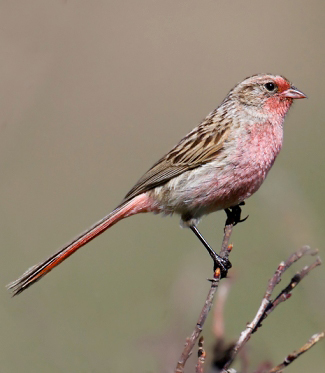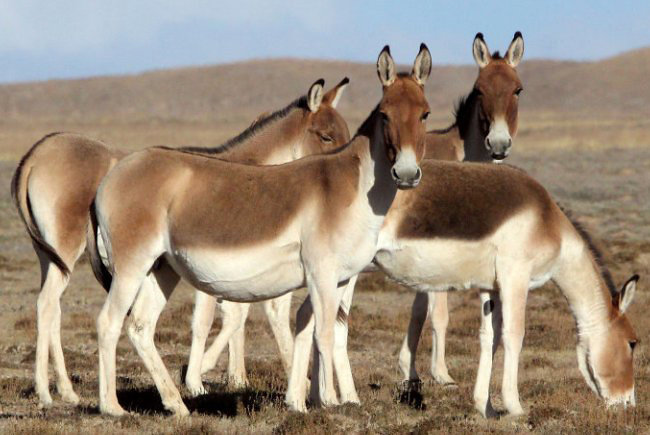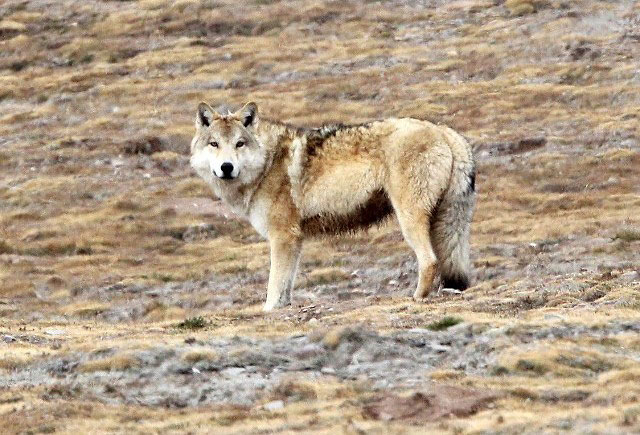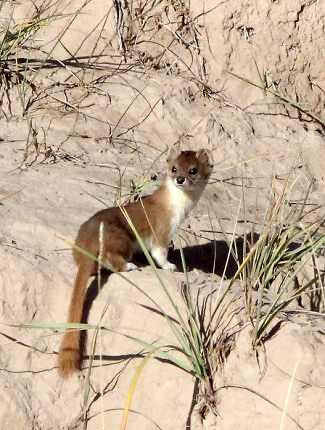

The unique Przevalski's Rosefinch or Pinktail at Rubber Mountain by Dubi Shapiro.
- Rare high-altitude birds including Przevalski’s Rosefinch or Pinktail, which is in a family all of its own
- As well as Blue and Tibetan Eared-pheasants, Black-necked Crane, Tibetan Sandgrouse, Snow Pigeon, Ala Shan Redstart, Crested and White-browed Tit-warblers, Ground Tit, Giant Babax, snowfinches, rosefinches and Tibetan Bunting
- And more widespread spectacular species such as Bar-headed Goose, Lammergeier, Saker Falcon, Ibisbill, Pallas’s Sandgrouse,
Chinese and Siberian Rubythroats,
and Wallcreeper - With mammals such as Tibetan Wild Ass
- And Tibetan Gazelle, Blue Sheep and pikas, plus a chance of Yak and 'Tibetan' Wolf
- All in some of the most spectacular landscapes on Earth, on and around the rolling plains of the Tibetan Plateau, average height 4500 m (15,000 ft)!
- Przevalski's Rosefinch or Pinktail Urocynchramus pylzowi is a unique bird, in its own genus and family; the Urocynchramidae. It has been named after Nikolay Przhevalsky, a Russian geographer, rumoured in some circles to be the biological father to Joseph Stalin, and seems to be restricted to alpine scrub above 10,000 feet (3048 m) on the Qinghai-Tibet Plateau region of central China.
- To see birds such as Przevalski's Rosefinch it is necessary to travel above and beyond 10,000 feet (3048 m). Indeed, the whole of Tibet lies at altitudes between 9842 and 15,748 feet (3000 and 4800 metres) and over half of the plateau is situated above 13,500 ft (4000 m), hence it is an unsuitable destination for anyone with heart or lung conditions which may be aggravated by such high altitudes. Even fit and relatively fit visitors would be wise to acclimatize for a few days in Lhasa at the beginning of a tour.
- The vast Tibetan Plateau lies in the rain shadow of the Himalayas. The northern plateau especially is very dry and very cold, inhospitable to hordes of humans – some manage to eke out an existence there - but home to large numbers of grazing animals, including antelopes, argalis, gazelles, sheep and wild Yaks, along with their predators such as wolves. The largest of the five major reserves on the plateau is the rarely visited Chang Tang, described in George Schaller’s great book Tibet’s Hidden Wilderness published in 1997. He and his wife were the first westerners permitted to enter the region in 1988. Now it is possible for anyone to visit the windswept arenas of high-altitude plains surrounded by snowy peaks, albeit on full-scale expeditions mounted by specialists. The lack of roads and water makes travelling through the terrain particularly difficult but the hassle and expense involved in reaching one of the few truly remote regions left on the planet are well worth it for the spectacular landscapes are completed by spectacular wildlife, not least herds of what may be the most handsome ‘horses’ on Earth; the chestnut and white Tibetan Wild Asses, or as the Tibetans call them, Kiangs.
- Tibet is sometimes combined with neighbouring Sichuan, best visited in May, mainly for the numerous spectacular birds there and a good chance of seeing Red Panda.

Tibetan Wild Asses by Coke & Som Smith.

'Tibetan' Wolf by Coke & Som Smith.
Best Birds and other wildlife in Tibet
Birds
The lists below are for the northern summer.
Chinese endemics 72 (+ 6 on Hainan Island) - not all of these occur in Tibet (A monal, a tragopan, six pheasants, a ground-jay, five parrotbills and ten laughingthrushes) Sichuan Partridge, Collared (White-necklaced) Partridge, Przevalski’s Partridge, Chinese Bamboo Partridge, Chestnut-throated (Verreaux’s) Partridge, Chinese Monal, Cabot’s Tragopan, Elliot’s Pheasant, Reeves’s Pheasant, Golden Pheasant, White Eared-pheasant, Brown Eared-pheasant, Blue Eared-pheasant, Chinese (Severtzov’s) Grouse, Asian Crested Ibis (being reintroduced to Japan), Sichuan (Pere David’s) Owl, Chinese Barbet, Dark-bodied (Eurasian Three-toed) Woodpecker, Giant (Chinese) Grey Shrike, Sichuan Jay, Xinjiang Ground-jay, Yellow-bellied Tit, White-browed Tit, Rusty-breasted (Pere David’s) Tit, Sichuan Tit, Chinese Cupwing, Sichuan Grasshopper-warbler, Emei Leaf-warbler (winter range unknown, possibly Myanmar), Gansu Leaf-warbler (winter range unknown), Alpine Leaf-warbler, Sooty Tit, Silver-throated Tit, Rufous-tailed Babbler, Tarim Hill-warbler (Babbler), Grey-hooded Fulvetta, Chinese Fulvetta, Spectacled Fulvetta, Three-toed Parrotbill, Spectacled Parrotbill, Yunnan (Brown-winged) Parrotbill, Grey-hooded Parrotbill, Rusty-throated Parrotbill, Grey-sided Scimitar-babbler, Nonggang Babbler, Golden-fronted Fulvetta, Huet’s (Grey-cheeked) Fulvetta, Barred Laughingthrush, White-speckled (Biet’s) Laughingthrush, Giant Laughingthrush, Snowy-cheeked Laughingthrush, Plain (Pere David’s) Laughingthrush, Giant Babax, Tibetan Babax, Buffy Laughingthrush, Blue-crowned (Yellow-throated) Laughingthrush, Brown-cheeked (Prince Henry’s) Laughingthrush, Emei Shan (Grey-faced) Liocichla, Sichuan Treecreeper, Przevalski’s (White-cheeked) Nuthatch, Chinese Thrush, Chinese Shortwing, Ala Shan Redstart, Przevalski’s Rosefinch (Pinktail), Tibetan Snowfinch, Pink-rumped Rosefinch, Chinese Beautiful Rosefinch, Tibetan Rosefinch, Sillem’s Rosefinch, Three-banded Rosefinch (likely to occur in adjacent Indian subcontinent), Chinese White-browed Rosefinch (recorded in India), Tibetan Bunting and Slaty Bunting.
(Blackthroat breeds in north-central China. Its non-breeding grounds are unknown but it has been recorded in northwest Thailand although possibly only as a vagrant)
(Vaurie’s Nightjar is known only from the type specimen from Pishan, southwest Xinjiang, in the west)
Specialities
Blood Pheasant, Tibetan Eared-pheasant, Buff-throated (Szechenyi’s) Partridge, Tibetan Snowcock, Tibetan Partridge, Black-necked Crane, Ibisbill, Pallas's
and Tibetan Sandgrouse, Snow Pigeon, Grey-crested Tit, Ground Tit (Hume’s Ground-jay), Asian Azure-winged Magpie, Tibetan Lark, Crested and White-browed
Tit-warblers, Snowy-browed (Chinese) Nuthatch, Wallcreeper, Chinese (White-tailed) Rubythroat, Hodgson’s, White-bellied and White-throated Redstarts,
Elliot's Laughingthrush, Green-crowned Warbler, Brown-throated (Ludlow’s) Fulvetta, snowfinches, Great and Streaked Rosefinches, and Tibetan Siskin. Also a
chance of Pallas’s Fish-eagle, Demoiselle Crane, Lord Derby’s Parakeet, Grandala and Maroon-backed Accentor.
Others
Bar-headed Goose, Ruddy Shelduck, Himalayan Griffon, Lammergeier, Golden Eagle, Upland Buzzard, Saker Falcon, Brown-headed and Great Black-headed
(Pallas's) Gulls, Hill Pigeon, Grey-backed Shrike, Daurian Jackdaw, Asian Short-toed and Hume’s Larks, warblers, Desert and Isabelline Wheatears,
Slaty-backed Flycatcher, Blue-fronted and Güldenstädt's Redstarts, Siberian Rubythroat, Chestnut and Kessler’s Thrushes, Brown, Robin and Rufous-breasted
Accentors, Twite, Grey-headed Bullfinch, White-winged Grosbeak, and Brandt’s (Black-headed) and Plain Mountain-finches.
Mammals
Tibetan Wild Ass (Kiang), Blue Sheep, Tibetan Gazelle, Chinese Goral, Himalayan Marmot and pikas. Also a chance of Yak (most of the remaining wild
Yaks, about a thousand in 2014, are in Hoh Xil NNR), 'Tibetan' Wolf, Pallas's Cat, Tibetan Antelope, Goitered and Przewalski's Gazelles, Mountain
Weasel and Tibetan Dwarf Hamster.
Other Natural Wonders in Tibet
Tsangpo Canyon
With an average altitude of about 3000 m (10,000 ft) the Tsangpo River is the highest river on Earth. In the Tsangpo Canyon, one of the largest canyons
in the world, the river drops about 2700 m (9000 ft) in just 2414 km (1500 miles), before becoming the Brahmaptura which runs through northeast India.
Lake Manasarova
This 320 sq km (125 sq mile) body of blue and emerald water is the highest freshwater lake in the world, lying at 4586 m (15,049 ft). It freezes over
completely during the winter.
Best Sites for Birds and other wildlife in Tibet

Mountain Weasel by Coke & Som Smith.
- Dong Xia, Xining Przevalski’s and Snowy-browed Nuthatches, Crested Tit-warbler and Gansu Leaf-warbler.
- Huzhu Bei Shan FR Blue Eared-pheasant, Severtzov’s Grouse, White-browed Tit-warbler and Gansu Leaf-warbler. Also a chance of White-winged Grosbeak.
- Koko Nor (Qinghai Hu) (3200 m, 10,499 ft) Bar-headed Goose, Black-necked Crane, Great Black-headed Gull, Ground Tit and snowfinches. Also a chance of Pallas’s Fish-eagle.
- Chaka area including Rubber Mountain Przevalski’s Partridge, Pallas’s Sandgrouse, Ala Shan and Güldenstädt’s Redstarts, Przevalski’s Rosefinch and snowfinches.
- Er La Pass, Wenquan (nearly 4500m, 14,765 ft) Tibetan Snowcock, Tibetan Sandgrouse, Güldenstädt’s Redstart, Tibetan Rosefinch and Brandt’s Mountain-finch.
- Wenquan to Yushu Tibetan Wild Ass, Tibetan Gazelle, Bar-headed Goose, Lammergeier, Himalayan Griffon, Saker Falcon and Black-necked Crane.
- Yushu to Nangqian Ibisbill and Kessler’s Thrush.
- Nangqian, including Kanda Shan Pass (4600-5000 m, 15,000-16,400 ft) Tibetan Babax, Tibetan Bunting and Przevalski’s Rosefinch, as well as White Eared-pheasant, Tibetan Snowcock, Tibetan Partridge, Golden Eagle, Snow Pigeon, White-browed Tit, Wallcreeper, White-browed Tit-Warbler, Chinese Rubythroat, Chinese Beautiful, Pink-rumped and Streaked Rosefinches, White-winged Grosbeak and Plain Mountain-finch. Also a chance of Grandala.
- Beizha Forest Blood Pheasant, White Eared-pheasant, Buff-throated Partridge, Grey-crested Tit, Crested Tit-warbler, Tibetan Babax, Giant Laughingthrush and Three-banded Rosefinch. Also a chance of Maroon-backed Accentor.
- Qamdo (Chamdo) to Bomi A chance of Lord Derby’s Parakeet.
- Bomi to Lulang A chance of Lord Derby’s Parakeet, Green-crowned Warbler and Ludlow’s Fulvetta.
- Lhasa Tibetan Eared-pheasant, White-browed Tit-warbler, Giant Babax, Brown-cheeked Laughingthrush and Streaked Rosefinch.
Best Times for Birds and other wildlife in Tibet
Late May to mid August is the best time for birds, when breeding species are at their most active and attractive, May to October for mammals. During the height of summer in July temperatures range between 15°C and 25°C when it is sunny but there may be some rain or snow showers and it is much colder at night. Warm, waterproof and windproof layered clothing is therefore recommended.
Recommended Bird Books etc. for Tibet
Birds of the Indian Subcontinent by R Grimmett, and C and T Inskipp. Helm, 2012.
A Field Guide to the Birds of the Indian Subcontinent by K Kazmierczak. Helm, 2008.
A Field Guide to the Birds of China by J MacKinnon and K Phillipps. OUP, 2000.
Tibet and its Birds by C Vaurie. H F & G Witherby, 1972.
Mammals of China (Pocket Edition) edited by A Smith and Y Xie. PUP, 2013.
A Guide to the Mammals of China by A Smith, Y Xie et al. PUP, 2008.
The Mammals of China by Sheng Helin et al. China Forestry Publishing House, 1999.
Apps etc.
eGuide to Birds of the Indian Subcontinent.
Where to watch birds in Asia by N Wheatley. Helm, 1996.
Don’t know which country/countries/regions to visit in Asia? Then it may be worth considering taking a look at this book, written by this website’s author. It is many years old of course but it still provides a starting point, an overview and a guiding light to the best birds and the best places to look for them in the region, and could save hours of searching for similar information on the internet. However, it is important to check more up-to-date sources for sites which have been opened up, sites and species which have been discovered, lodges that have been built etc. since the book was published.
Birding and Wildlife Trip Reports for Tibet
Many trip reports, some for Tibet, are posted on the websites listed here. On some of these websites some reports are independent and some are posted by tour companies who organize tours to Tibet. These tour companies and others also post their own reports on their websites, which are listed under 'Some Organized Tours to Tibet' below.
- The best website for trip reports is CloudBirders
- but these are also worth a look
- Birdtours
- Fatbirder
- Jon Hornbuckle
- Mammal Watching
Local bird and wildlife guides in Tibet
The costs of organized tours partly reflect the quality of the tour leaders. Some leaders are certainly better than others and many companies claim their leaders are the best but even the best rely at least to some extent on the exceptional skills of the local guides they employ. If you are travelling independently, employing such local guides will greatly increase your chances of seeing the wildlife you wish to see.
- China Bird Tour
- China based birding tour company since 1999 specializing in providing local arrangements for worldwide birding companies and individual birders within China, including all hot spots.
- Jesper Hornskov at goodbirdmail@gmail.com or goodbirdmail@126.com
- Tibet Eco-Tours
Accommodation for birders in Tibet
Some Organized Tours for birds and other wildlife to Tibet
There are many tour companies who organize tours to see mammals, birds, other wildlife and other natural wonders. The cost of these tours vary considerably according to such variables as the airlines used, the number of days the tours last, the number of sites visited, the number of people in the group (an important consideration if you wish to see such wildlife as rainforest mammals and birds), the number of tour leaders, the standard of accommodation and transport, and the percentage profit the company hopes to make. Generally, where the number of days tours last and the number of sites visited are similar, the cheapest tours are those that use the cheapest airlines, accommodation and local transport, that have the largest groups with the least number of leaders, and that make the least amount of profit. The most expensive tours tend to be those which are exceptionally long, use the most expensive accommodation (ridiculously lavish in some cases, even for single nights) and which make the most profit. Some tour costs partly reflect the quality of the tour leaders. Some leaders are certainly better than others and many companies claim their leaders are the best but even the best rely at least to some extent on the exceptional skills of the local guides they employ.
While tour companies organize tours with set itineraries many also organize custom tours for individuals and private groups who instead of taking a tour with a set itinerary want to follow their own itinerary to suit their own personal tastes, whether it be mammals, birds, other wildlife, other natural wonders or even man-made attractions, or a mixture of them all. Many organized tours with set itineraries are also fast-paced and target as many species as possible, whether they are mammals, birds or other wildlife or everything, which usually leaves little time to enjoy the best sites and individual species, but on a custom tour those taking part can specify the pace and the sites and species they wish to concentrate on. Custom tours also suit people who like to travel with people they already know, rather than with a group of strangers, and people with partners with different interests. Individuals and small groups will almost certainly have to pay more than the price of an organized tour with a set itinerary but a large group of friends may be able to travel for less than the price quoted for a set tour.
Tour companies who are running organized tours to Tibet in the next couple of years include the following. Many of these also offer custom tours.
